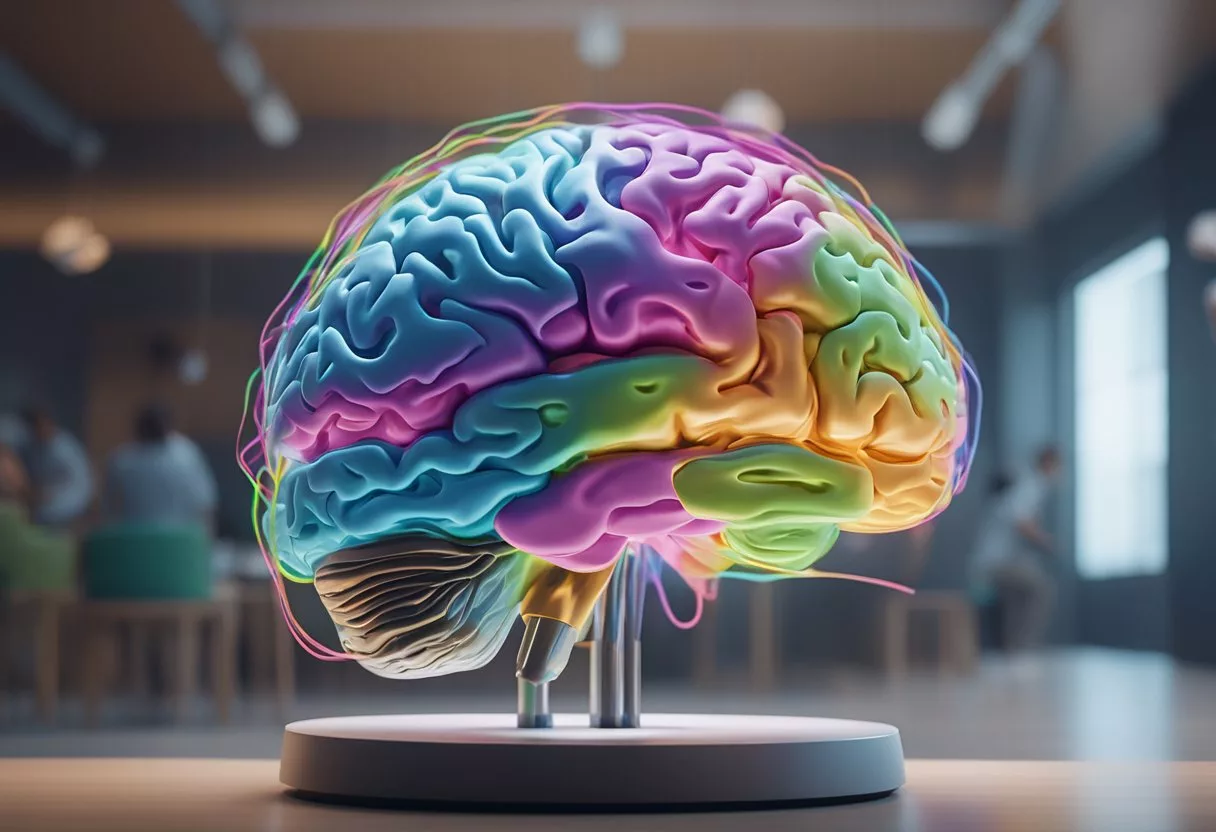Emotional resonance is the phenomenon where an individual’s emotions significantly align with another person’s emotional state or with the emotions conveyed in a story, piece of music, or work of art. It is a powerful force that can deepen connections and understanding between people. It can also enhance the impact of media and art on its audience.
Happiness, being one of the most sought-after emotions, is both a cause and effect of emotional resonance. When people share their joy or even express contentment through various forms of communication, it often creates a ripple effect, fostering positive emotional experiences in others.

The study of happiness and emotional resonance spans multiple disciplines, including psychology, neuroscience, and sociology.
Through this, experts aim to decipher how emotions, particularly happiness, are not just personal experiences but are interconnected with the social fabric we live in.
Functional magnetic resonance imaging studies have extensively mapped out how the brain processes emotions such as happiness. This has contributed to a better understanding of the emotional components that play a role in our overall sense of well-being.
Key Takeaways
- Emotional resonance connects individuals by aligning emotions, enhancing social bonds and experiences.
- The pursuit of happiness can trigger emotional resonance, creating a positive feedback loop in social contexts.
- Interdisciplinary research continues to uncover the complexities of how emotions are processed and shared within cultures.
Understanding Emotional Resonance

Emotional resonance is a complex phenomenon involving one’s ability to share and understand the emotions of others. It is underpinned by neurological processes and manifesting in observable behaviors like facial expressions.
The Role of Empathy in Emotional Resonance
Empathy is crucial in emotional resonance as it allows individuals to experience and comprehend the affective states of others. This emotional resonance is often automatic and can manifest early in life, as exemplified by infants responding to the cries of their peers.
This empathic response is not just a surface reaction; it signifies a deeper connection where one literally ‘feels with’ the other.
Neurological Foundations
Neuroscience research has found that certain neural substrates, including the mirror neuron system, are instrumental in emotional resonance.
These mirror neurons activate both when an individual experiences an emotion and when they observe the same emotion in someone else, forging a link between self and others.
Neuroimaging studies provide evidence of these neural mechanisms at work. Furthermore, the delicate interplay of neurotransmitters and hormones are implicated in affording the capacity for emotional resonance.
Emotion Recognition and Facial Expressions
A significant aspect of emotional resonance is the ability to recognize emotions through facial expressions.
Individuals often rely on facial cues to determine others’ emotional states, enabling a resonant experience.
Studies have demonstrated that certain conditions, such as the ingestion of mood-congruent substances, can enhance the recognition of emotions, thus contributing to more effective emotion sharing.
This suggests that facial expressions are powerful conveyors of emotional information, which can trigger resonant feelings in observers.
Harnessing Happiness

In the pursuit of happiness, science reveals a strong interplay between emotional experiences and daily practices. Understanding the mechanics of positive emotions and the influence of nutrition opens new pathways for enhancing well-being.
Positive Emotions and Well-Being
Positive emotions, such as joy and contentment, are central to the concept of well-being. They do not just reflect happiness; they also contribute to it, fueling a cycle of positive experiences and perceptions.
Research shows that consistent engagement with positive affect can build resilience against negative mood states and bolster psychological health.
One facet of positive emotions can be attributed to emotional resonance. This is the phenomenon where certain experiences, including music that aligns with one’s own emotional state, amplify feelings of happiness.
Similarly, the satisfaction of social connections, as mentioned in the text “Love 2.0: Creating happiness and health in moments of connection,” acts as catalysts in this process.
Nutrition and Emotional States
Nutrition plays a critical role in moderating one’s emotional state. Specific food substances have been linked to the enhancement of mood and overall sense of happiness.
For instance, the consumption of chocolate is widely recognized for its ability to improve mood due to the presence of compounds like tryptophan and phenylethylamine.
Additionally, particular dietary patterns have been associated with reduced symptoms of depression and anxiety.
It suggests a direct correlation between what one eats and their emotional well-being. The concept of food-induced emotional resonance indicates the potential harnessing of dietary choices to support a positive emotional state.
The Social Dimension of Emotion

Emotions are not solitary experiences; they are intricately connected with our social fabric. This section explores how our relationships impact our emotional states and the role of shared experiences in our social interactions.
Relationships and Emotional Support
Relationships form the backbone of emotional well-being, providing a platform for emotional support.
In times of distress, they offer a shoulder to lean on, fostering an environment where individuals feel understood and valued.
The bond between people serves as a conduit for compassion, enabling them to offer and receive consolation and encouragement.
The positive impact of emotional support from relationships is documented in numerous studies, indicating a correlation between robust social ties and enhanced mental health.
Social Interactions and Shared Experiences
Social interactions and shared experiences shape our emotional landscape.
Collective joy, for example, is often at its peak during group celebrations and societal milestones, where individuals experience high levels of emotional synchronization.
Moreover, experiences of shared emotion can intensify one’s own feelings due to emotional contagion, a phenomenon where individuals absorb and mirror the emotions of those around them.
Society flourishes when its members partake in shared experiences that evoke feelings of unity and belonging.
Such experiences are integral to developing emotional empathy, the capacity to understand and share the feelings of another, which is essential for healthy social functioning.
Communication and Expression

Effective communication and expression of emotions involve a complex interplay between linguistic choices and nonverbal cues, contributing to the overall emotional resonance in interactions. Understanding the language of emotions and the power of nonverbal emotional cues enables individuals to convey and interpret feelings with greater clarity and depth.
The Language of Emotions
When it comes to the linguistic component of emotional expression, individuals choose words that are imbued with affective meaning, capable of eliciting an emotional response in the listener.
This “language of emotions” is not just about the words themselves but also the cognitive component – the ideas and concepts the words represent.
Linguistic expressions range from direct statements like “I’m happy,” to metaphorical language that evokes a sense of sadness or joy.
Studies suggest that the stance a speaker takes—essentially, their attitude or viewpoint—plays a critical role in how they project emotions linguistically and how these are received by others.
Nonverbal Emotional Cues
Nonverbal communication is a powerful conduit for the expression and recognition of emotions.
It includes aspects like eye contact, which can signal trust and openness, and posture, which can demonstrate confidence or uncertainty.
The tone of voice adds a nuanced layer to the spoken word, often revealing underlying emotions that the words alone might not convey.
Bodily communication, such as gestures, also offers valuable information about a person’s emotional state.
Cognitive processes like the visual recognition of emotion facilitate the interpretation of these nonverbal signals by the observer.
This profound level of response and interaction suggests a shared neurological basis in both expressing and perceiving emotions.
Emotional Influence on Behavior

The intricate relationship between emotions and behavior is evident across a spectrum of human experiences. Emotional states can serve as catalysts for behavior, shaping our personal motivation, while the capacity for emotional distance can influence how individuals respond to situations.
Emotional Distance and Responses
Emotional distance refers to the ability to maintain a degree of separation from one’s immediate emotional reactions. This can play a pivotal role in determining how a person responds to situations.
Those who master this can objectively process events without allowing their emotions to dictate their reactions, leading to more rational decision-making.
For example:
- Statistically Significant Impact Data:
- Close emotional distance: Immediate emotional response with potential for hasty decisions.
- Considerable emotional distance: Analytical response with deliberate, considered decisions.
The ability to regulate emotional responses based on the degree of emotional distance is essential. This is especially true in professional or high-stakes environments where subjective emotions may cloud critical judgment.
Clinical Perspectives

In examining the relationship between emotion, mental health, and treatment, clinical perspectives underscore the significance of understanding emotional resonance and happiness to improve patient outcomes.
These insights are pivotal in tailoring therapeutic interventions for emotional disorders and addressing the emotional dimensions in patient care.
Emotional Disorders and Treatment
Patients with emotional disorders such as schizophrenia often experience disrupted emotional resonance, impacting their ability to relate to others’ emotions.
Clinicians are increasingly aware that theory of mind mechanisms and neural systems for recognizing emotion play crucial roles in these conditions.
Treatment protocols may include therapies that engage somatosensory cortices. These aim to enhance patients’ capacity to process and respond to emotional stimuli.
An effective treatment approach also integrates a focus on the patients’ subjective experiences. This emphasizes compassion and concern for their emotional well-being.
The Impact of Emotions on Patient Care
In the clinical setting, understanding and responding to patients’ emotions is vital. Healthcare providers who recognize the importance of emotional resonance are better equipped to offer compassionate care that considers patients’ psychological states.
This recognition involves an intricate dance between the patient’s emotional expressions and the clinician’s response. The clinician’s response is mediated by the clinician’s own theory of mind and the neural circuitry involved in emotion recognition.
The aim is always to foster an environment where patients feel understood—a critical component in the healing process.
Cultural and Environmental Factors

Emotional resonance and happiness are profoundly influenced by the cultural context and the environment in which individuals live. These factors shape how emotions are expressed, understood, and valued across different societies.
Cross-Cultural Views of Emotion
In literature and storytelling, emotion recognition can greatly vary from one culture to another.
For example, certain cultures prioritize emotional restraint and view overt expressions of happiness as less appropriate, while others may encourage more expressive behaviors.
Society’s interpretation of emotions is often depicted through narratives, where protagonists embody culturally appropriate emotional responses.
For instance, research has highlighted how empathic resonance, or the shared feeling between individuals, can differ based on cultural scripts and social norms: An interactionist perspective.
The Influence of Nature and Environment
Nature and one’s immediate environment play a critical role in shaping overall happiness.
Access to green spaces and natural settings has been connected to higher levels of well-being and reduced stress.
The presence of plants and natural elements in one’s surroundings can elicit positive emotional states and reinforce a sense of well-being.
Additionally, environmentally sustainable practices within a city or community reflect a commitment to the quality of life. This can contribute to the happiness of residents, as seen in the human-centric approach to tourism city development Tourism city development.
Advances in Emotional Resonance Research

Emotional resonance, the phenomenon where individuals sync emotionally with one another, has seen significant progress through advances in neuroimaging and the investigation of embodied emotion theory.
Neuroimaging and Brain Activity
Recent research has leveraged neuroimaging techniques like functional MRI (fMRI) to observe brain activity associated with emotional resonance.
Studies indicate that when individuals connect emotionally, there is increased activity within regions such as the insula and prefrontal cortex. This suggests these areas may help regulate shared emotional experiences.
Neuroimaging studies with children and adults demonstrate that certain neural pathways become more active during tasks that require emotional understanding and empathy. This reinforces the role of brain activity in emotional connectivity.
Investigating the Embodied Account of Emotion
The embodied account of emotion suggests that emotional experiences are influenced by bodily responses and simulations.
Through sensory and motor processes, individuals may experience empathy by mirroring others’ emotional states.
Researchers are studying this phenomenon by observing the responses of individuals when they are exposed to the emotional expressions of others.
Experimental designs often include asking subjects to mimic facial expressions or measure their physiological responses to emotional stimuli.
These investigations have begun to elucidate how emotions are not only felt internally but are also expressed and interpreted through the body’s external interactions.
The Art and Science of Storytelling

The artful blending of narrative elements can create a powerful emotional resonance, while the science of storytelling offers tools and techniques to maximize this impact. This interplay is critical in crafting stories that not only engage but also elicit a deep emotional response from the audience.
Eliciting Emotions Through Narrative
Narratives are a potent means to evoke emotions, forming an integral part of how humans communicate and connect.
Emotion plays a pivotal role in the processing of emotional stimuli, influencing both the teller and the audience.
When a story resonates emotionally, it can become contagious, creating a shared experience that binds the listener to the narrative.
- Joy: Incorporating moments of triumph or happiness can invoke joy, fostering a bond with the characters.
- Sadness: Introducing loss or hardship can lead to a poignant response, often increasing the depth of the audience’s emotional investment.
- Surprise: Clever plot twists sustain interest and can lead to heightened emotional engagement.
The evaluation of these emotional effects is not just subjective; neuroscientific research has unpacked how specific narrative components can trigger an emotional response.
This knowledge allows storytellers to strategically structure their stories to hit emotional beats that resonate with their audience.
Tools and Techniques for Effective Storytelling
Armed with an understanding of emotions, storytellers employ various tools to convey their message and ensure it resonates.
These techniques range from language use to pacing and structure:
- Imagery: Descriptive language that paints vivid mental pictures, enhancing the emotional atmosphere.
- Pacing: The tempo at which a story unfolds. Proper pacing can amplify emotions, building tension or providing relief at just the right moments.
- Structure: The architecture of a story. It includes the setup, conflict, and resolution, guiding the emotional journey of the audience.
Effective storytelling employs these techniques in a way that feels authentic and compelling.
The evaluation of a story’s impact can be seen in the audience’s reaction— laughter, tears, or a thoughtful silence.
By refining these tools, storytellers can craft narratives that not only tell a tale but also evoke an emotional experience that is memorable and meaningful.
Frequently Asked Questions

Emotional resonance is a fundamental aspect of psychological well-being, affecting happiness and interpersonal connections. It influences daily interactions and can be cultivated through specific practices grounded in psychological research.
How does emotional resonance contribute to overall happiness?
Emotional resonance involves sharing and understanding the emotions of others, which can enhance personal happiness by fostering a sense of connection and empathy.
What role does emotional resonance play in strengthening relationships?
It allows individuals to sync with others emotionally, creating deeper bonds and a supportive environment, essential for strong, enduring relationships.
In what ways can emotional resonance be exemplified in daily interactions?
Daily, it is demonstrated through active listening, empathetic responses, and the mutual sharing of emotions, providing opportunities for more meaningful engagement with others.
What methodologies exist to enhance one’s emotional resonance with others?
Methods to boost emotional resonance include practices like mindfulness, empathy training, and communication skills workshops. These fine-tune one’s ability to connect emotionally with others.
Can emotional resonance be developed, and if so, how?
Yes, individuals can develop emotional resonance through conscious effort, such as engaging in reflective listening, expressing empathy, and participating in social and emotional learning activities.
What are the scientific foundations of emotional resonance within the field of psychology?
The concept is rooted in psychological theories. These include mirror neuron research and affective neuroscience. These theories explore how humans understand and mirror the emotions of others.